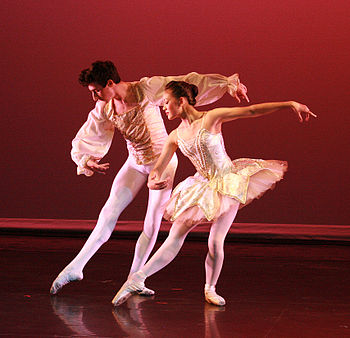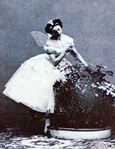主题:舞蹈
此主题目前正依照其他维基百科上的内容进行翻译。 (2017年4月6日) |
舞蹈主题
舞蹈是八大艺术之一,是于三度空间中以身体为语言作“心智交流”现象之人体的运动表达艺术,一般有音乐伴奏,以有节奏的动作为主要表现手段的艺术形式。它一般借助音乐,也借助其他的道具。舞蹈本身有多元的社会意义及作用,包括运动、社交/求偶、祭祀、礼仪等。
特色条目
Acrobatic dance emerged in the United States and Canada in the early 1900s as one of the types of acts performed in vaudeville. Although individual dance and acrobatic acts had been performed in vaudeville for several decades prior to 1900, it was not until the early 1900s that it became popular to perform acts that combined dance and acrobatic movements. Since the decline of the vaudeville era, acrobatic dance has undergone a multi-faceted evolution to arrive at its present-day form. The most significant aspect of this evolution is the integration of ballet technique as the foundation for dance movements, thus bringing into acro dance a precision of form and movement that was absent in vaudeville acrobatic dance.
特色图片

In ballet, a pas de deux is a dance duet in which two dancers, typically a male and a female, perform ballet steps together. It usually has five parts, consisting of an entrée (introduction), an adagio, two variations (a solo for each dancer), and a coda (finale). The pas de deux is characteristic of classical ballet and can be found in many well-known ballets. It is often considered to be the bravura highlight of a ballet and is usually performed by a leading pair of principal dancers.
特色传记
Emma studied dancing while young and attended the Paris Opera School. She made her debut at age sixteen with the Paris Opera as the sylph in La Sylphide. Her talent brought her fame and she became a widely respected ballerina.
Marie Taglioni noticed her during one of her performances and immediately took a liking to the girl, becoming her mentor. Marie choreographed for Emma in the ballet Le Papillon, a piece by Jacques Offenbach that was especially created just for Emma.
欢迎参与
分类
In arts • Awards • 芭蕾 • Ballroom • 啦啦队 • Competitive • Contemporary • Culture • Dancers • Dances • Education • By ethnicity or region • Folk • Health • Historical • Hip Hop • Lists • Magazines • Music • Musical theatre • Notation • Occupations • Organizations • Props • Syllabus-free • Technique • Television shows • Venues • Video games • Websites Writers •



